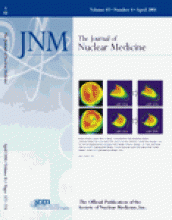TO THE EDITOR:
A recent article of Yoshikawa et al. (1) is especially interesting with their successful demonstration of 2 supplementary quantitative brain image analysis techniques. One is the statistical image created from z scores; the other is the voxel intensities’ integrated histogram fractal dimension (FD). Though applied to the diagnosis of vascular dementia using PET and SPECT studies here, the latter technique has appeared in recent years for diagnoses of other diseases (2–7). However, it is thought that such studies, including that of Yoshikawa et al., can benefit from examining some consequences of the mathematic foundation of the FD along with implications for using the method.
The method defines FD from the histogram p(x) of voxel intensities x as:
 Eq. 1 Evaluation is customarily performed by selecting a limited range of x values for an ln(1 − ∫p(x)dx) versus lnx plot for data fitting of a slope. Where p(x) is either normal or lognormal (i.e., lnx being normal), it follows in a straightforward analytic fashion from the explicit forms of these that, respectively:
Eq. 1 Evaluation is customarily performed by selecting a limited range of x values for an ln(1 − ∫p(x)dx) versus lnx plot for data fitting of a slope. Where p(x) is either normal or lognormal (i.e., lnx being normal), it follows in a straightforward analytic fashion from the explicit forms of these that, respectively:
 Eq. 2 The coefficient of variation CV = ςx/xavg and the SD ςL of the lnx values both characterize heterogeneity. CV, if not too large (e.g., less than 1), approximates ςL. The numbers k depend on the chosen data-fitting location relative to the distribution mean. If at the mean then there is equality, kN = kL = √(2/π); but these are larger or smaller than this if fitting is above or below the mean, respectively (7). In support of Equation 2 are 2 strong correlations found by Murase et al. (2): between FDs and CVs and between FDs and spatial filter bandwidth, which directly influences ςx and, hence, CV. This interpretation of FD, as depending on a distribution’s localized shape constant and the reciprocal of CV, is derived for 2 specific distributions. The 18F-FDG PET studies of Cho et al. (8) on controls and Alzheimer’s patients gave distributions suggesting normal (skews near −0.3) more than lognormal (skews near −1). With skewed distributions, this interpretation of Equation 2 could remain, but with k being specific to its skew.
Eq. 2 The coefficient of variation CV = ςx/xavg and the SD ςL of the lnx values both characterize heterogeneity. CV, if not too large (e.g., less than 1), approximates ςL. The numbers k depend on the chosen data-fitting location relative to the distribution mean. If at the mean then there is equality, kN = kL = √(2/π); but these are larger or smaller than this if fitting is above or below the mean, respectively (7). In support of Equation 2 are 2 strong correlations found by Murase et al. (2): between FDs and CVs and between FDs and spatial filter bandwidth, which directly influences ςx and, hence, CV. This interpretation of FD, as depending on a distribution’s localized shape constant and the reciprocal of CV, is derived for 2 specific distributions. The 18F-FDG PET studies of Cho et al. (8) on controls and Alzheimer’s patients gave distributions suggesting normal (skews near −0.3) more than lognormal (skews near −1). With skewed distributions, this interpretation of Equation 2 could remain, but with k being specific to its skew.
Some implications of Equation 2 are:
Discriminations between controls and diseased can be from a graphical FD, or from ςL or CV determined numerically. Either approach may benefit from optimal choices of data-fitting range and voxel bandwidth. Also, which marker, or perhaps their product, diagnostically excels would depend on the relative sign and importance of changes in normals versus diseased of k (characterizing shape and fitting location) and ςL or CV (characterizing spread).
As a reference or normalization, some average of the voxels can be considered—for example, using x = voxel raw counts ÷ brain, body, or reference region average. However investigators, including Yoshikawa et al. (1), typically use for reference the highest voxel intensity, with the data-fitting range based on fractions of it. As a patient-specific single value, statistical variability (or worse yet, unusually large outliers) in this reference leads to corresponding interpatient variability: in defining the data-fitting range, in its associated k value, and, hence, in the FD according to Equation 2.
Reporting values of xavg or [lnx]avg would be appropriate, though this is never done. This, together with the data-fitting range, would provide a means for identifying where in the distribution the FDs are being determined and what k value (or values) in Equation 2 is in effect among controls and diseased.
This last implication suggests a possibility of having different k values operable in Equation 2 as perhaps partially explaining a discrepancy: In spite of a common use of 99mTc-hexamethylpropyleneamine oxime SPECT in brain studies and similar reconstruction filters (0.20 and 0.25 cycle/pixel), mental normals of Yoshikawa et al. (1) and those of Nagao et al. (5) have population average FDs differing quite remarkably by a factor of 1.6. To promote reproducibility between institutions, considerably more detail in protocol description may be needed in publications. Possibly even validations by scanning simple phantoms could be appropriate, as were simulated by Murase et al. (2).
In conclusion, for FD analyses it is worth keeping in mind the relationships among image quantifiers when seeking a best diagnostic marker (9). Also, a brain, body, or reference region voxel average can be considered as a stable reference when defining a data-fitting range.







